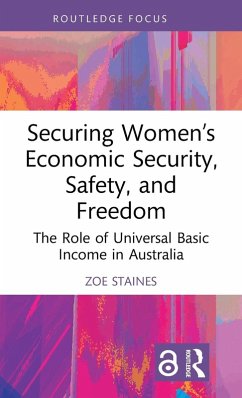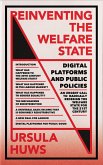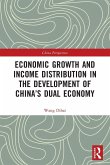Zoe Staines (University of Queensland)
Securing Women's Economic Security, Safety, and Freedom
The Role of Universal Basic Income in Australia
Zoe Staines (University of Queensland)
Securing Women's Economic Security, Safety, and Freedom
The Role of Universal Basic Income in Australia
- Gebundenes Buch
- Merkliste
- Auf die Merkliste
- Bewerten Bewerten
- Teilen
- Produkt teilen
- Produkterinnerung
- Produkterinnerung
Universal Basic Income (UBI) as a policy measure for supporting economic security has attracted worldwide attention. This book contributes to the discussion by focusing on UBIâ s potential impacts for women, including women of colour and First Nations women.
Andere Kunden interessierten sich auch für
![Tools for Spatial Economic Planning Tools for Spatial Economic Planning]() Gulelat KebedeTools for Spatial Economic Planning55,99 €
Gulelat KebedeTools for Spatial Economic Planning55,99 €![Reinventing the Welfare State Reinventing the Welfare State]() Ursula HuwsReinventing the Welfare State27,99 €
Ursula HuwsReinventing the Welfare State27,99 €![Welfare Conditionality Welfare Conditionality]() Beth WattsWelfare Conditionality42,99 €
Beth WattsWelfare Conditionality42,99 €![Safety, Security, and Reliability of Robotic Systems Safety, Security, and Reliability of Robotic Systems]() Safety, Security, and Reliability of Robotic Systems43,99 €
Safety, Security, and Reliability of Robotic Systems43,99 €![The Politics of Crime, Punishment and Justice The Politics of Crime, Punishment and Justice]() Stephen FarrallThe Politics of Crime, Punishment and Justice43,99 €
Stephen FarrallThe Politics of Crime, Punishment and Justice43,99 €![Nation Building, State Building, and Economic Development Nation Building, State Building, and Economic Development]() Sarah C.M. PaineNation Building, State Building, and Economic Development71,99 €
Sarah C.M. PaineNation Building, State Building, and Economic Development71,99 €![Economic Growth and Income Distribution in the Development of China's Dual Economy Economic Growth and Income Distribution in the Development of China's Dual Economy]() Wang DihaiEconomic Growth and Income Distribution in the Development of China's Dual Economy57,99 €
Wang DihaiEconomic Growth and Income Distribution in the Development of China's Dual Economy57,99 €-
-
-
Universal Basic Income (UBI) as a policy measure for supporting economic security has attracted worldwide attention. This book contributes to the discussion by focusing on UBIâ s potential impacts for women, including women of colour and First Nations women.
Produktdetails
- Produktdetails
- Verlag: Taylor & Francis Ltd
- Seitenzahl: 138
- Erscheinungstermin: 25. Juni 2025
- Englisch
- Abmessung: 222mm x 145mm x 11mm
- Gewicht: 290g
- ISBN-13: 9781032957876
- ISBN-10: 1032957875
- Artikelnr.: 73779595
- Herstellerkennzeichnung
- Libri GmbH
- Europaallee 1
- 36244 Bad Hersfeld
- gpsr@libri.de
- Verlag: Taylor & Francis Ltd
- Seitenzahl: 138
- Erscheinungstermin: 25. Juni 2025
- Englisch
- Abmessung: 222mm x 145mm x 11mm
- Gewicht: 290g
- ISBN-13: 9781032957876
- ISBN-10: 1032957875
- Artikelnr.: 73779595
- Herstellerkennzeichnung
- Libri GmbH
- Europaallee 1
- 36244 Bad Hersfeld
- gpsr@libri.de
Zoe Staines is a senior lecturer and researcher at The University of Queensland, School of Social Science. Her research and qualifications, including PhD, span social policy, gender and work, critical criminology, and intersectionality. Her professional experiences extend across academia, government, and the non-profit sector.
Acknowledgements
Chapter 1: Introduction
What is known about a UBI for women?
UBI for women: Australia as a case study
Aims and approach of this book
Chapter 2: Putting UBI into context
Setting the scene: the Australian context
Australian social assistance: shifting sands
Australia and a UBI: A missed opportunity in 1975?
Conclusion
Chapter 3: Women's economic (in)security
An Australian UBI and women's overall economic security
UBI and caregiving
UBI and unpaid care
UBI and commodified care
Improving paid work
Supplementing shrinking and harmful social security nets
Increasing material support
Conclusion
Chapter 4: Violence against women
Escaping domestic & family violence
Escaping insecure and unsafe housing
Conclusion
Chapter 5: Women's health
UBI, resource scarcity, and health behaviours
UBI and people with disability
UBI and chronic stress
UBI and avoiding social security stigma
Conclusion
Chapter 6: Looking to the future
Getting the wider policy & program architecture right for Australian women
Reassessing Australia's couple rule
Improving access to escaping violence payments
Improving access to commodified care options
Amending existing Australian social security
(Re)prioritising collective bargaining
Concluding remarks
References
Appendices
Appendix 1 - Detailed summary of research methodology
Appendix 2 - Australian social expenditure (a)
Appendix 3 - Australian social expenditure (b)
Appendix 4 - Proportion of female employees by industry type
Appendix 5 - Remuneration by sex across female-dominated, male-dominated,
and mixed industries
Chapter 1: Introduction
What is known about a UBI for women?
UBI for women: Australia as a case study
Aims and approach of this book
Chapter 2: Putting UBI into context
Setting the scene: the Australian context
Australian social assistance: shifting sands
Australia and a UBI: A missed opportunity in 1975?
Conclusion
Chapter 3: Women's economic (in)security
An Australian UBI and women's overall economic security
UBI and caregiving
UBI and unpaid care
UBI and commodified care
Improving paid work
Supplementing shrinking and harmful social security nets
Increasing material support
Conclusion
Chapter 4: Violence against women
Escaping domestic & family violence
Escaping insecure and unsafe housing
Conclusion
Chapter 5: Women's health
UBI, resource scarcity, and health behaviours
UBI and people with disability
UBI and chronic stress
UBI and avoiding social security stigma
Conclusion
Chapter 6: Looking to the future
Getting the wider policy & program architecture right for Australian women
Reassessing Australia's couple rule
Improving access to escaping violence payments
Improving access to commodified care options
Amending existing Australian social security
(Re)prioritising collective bargaining
Concluding remarks
References
Appendices
Appendix 1 - Detailed summary of research methodology
Appendix 2 - Australian social expenditure (a)
Appendix 3 - Australian social expenditure (b)
Appendix 4 - Proportion of female employees by industry type
Appendix 5 - Remuneration by sex across female-dominated, male-dominated,
and mixed industries
Acknowledgements
Chapter 1: Introduction
What is known about a UBI for women?
UBI for women: Australia as a case study
Aims and approach of this book
Chapter 2: Putting UBI into context
Setting the scene: the Australian context
Australian social assistance: shifting sands
Australia and a UBI: A missed opportunity in 1975?
Conclusion
Chapter 3: Women's economic (in)security
An Australian UBI and women's overall economic security
UBI and caregiving
UBI and unpaid care
UBI and commodified care
Improving paid work
Supplementing shrinking and harmful social security nets
Increasing material support
Conclusion
Chapter 4: Violence against women
Escaping domestic & family violence
Escaping insecure and unsafe housing
Conclusion
Chapter 5: Women's health
UBI, resource scarcity, and health behaviours
UBI and people with disability
UBI and chronic stress
UBI and avoiding social security stigma
Conclusion
Chapter 6: Looking to the future
Getting the wider policy & program architecture right for Australian women
Reassessing Australia's couple rule
Improving access to escaping violence payments
Improving access to commodified care options
Amending existing Australian social security
(Re)prioritising collective bargaining
Concluding remarks
References
Appendices
Appendix 1 - Detailed summary of research methodology
Appendix 2 - Australian social expenditure (a)
Appendix 3 - Australian social expenditure (b)
Appendix 4 - Proportion of female employees by industry type
Appendix 5 - Remuneration by sex across female-dominated, male-dominated,
and mixed industries
Chapter 1: Introduction
What is known about a UBI for women?
UBI for women: Australia as a case study
Aims and approach of this book
Chapter 2: Putting UBI into context
Setting the scene: the Australian context
Australian social assistance: shifting sands
Australia and a UBI: A missed opportunity in 1975?
Conclusion
Chapter 3: Women's economic (in)security
An Australian UBI and women's overall economic security
UBI and caregiving
UBI and unpaid care
UBI and commodified care
Improving paid work
Supplementing shrinking and harmful social security nets
Increasing material support
Conclusion
Chapter 4: Violence against women
Escaping domestic & family violence
Escaping insecure and unsafe housing
Conclusion
Chapter 5: Women's health
UBI, resource scarcity, and health behaviours
UBI and people with disability
UBI and chronic stress
UBI and avoiding social security stigma
Conclusion
Chapter 6: Looking to the future
Getting the wider policy & program architecture right for Australian women
Reassessing Australia's couple rule
Improving access to escaping violence payments
Improving access to commodified care options
Amending existing Australian social security
(Re)prioritising collective bargaining
Concluding remarks
References
Appendices
Appendix 1 - Detailed summary of research methodology
Appendix 2 - Australian social expenditure (a)
Appendix 3 - Australian social expenditure (b)
Appendix 4 - Proportion of female employees by industry type
Appendix 5 - Remuneration by sex across female-dominated, male-dominated,
and mixed industries








